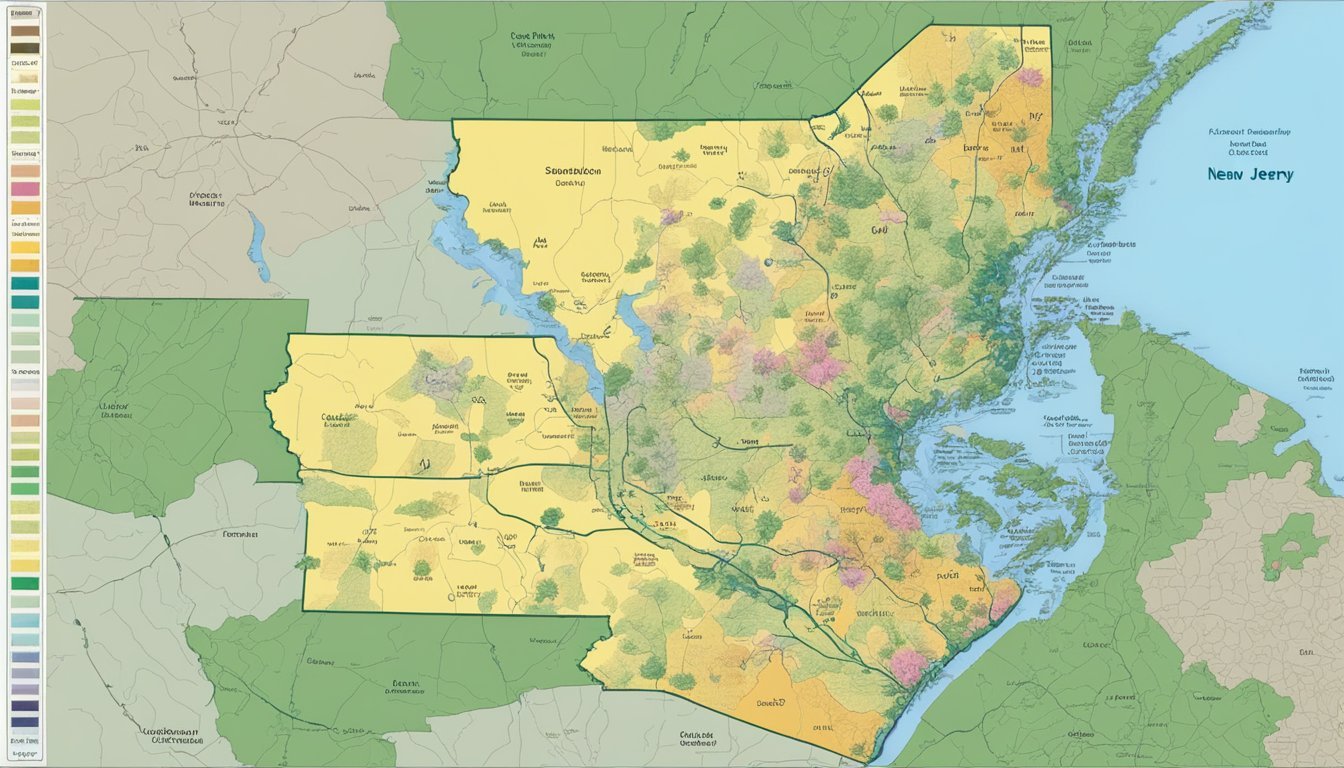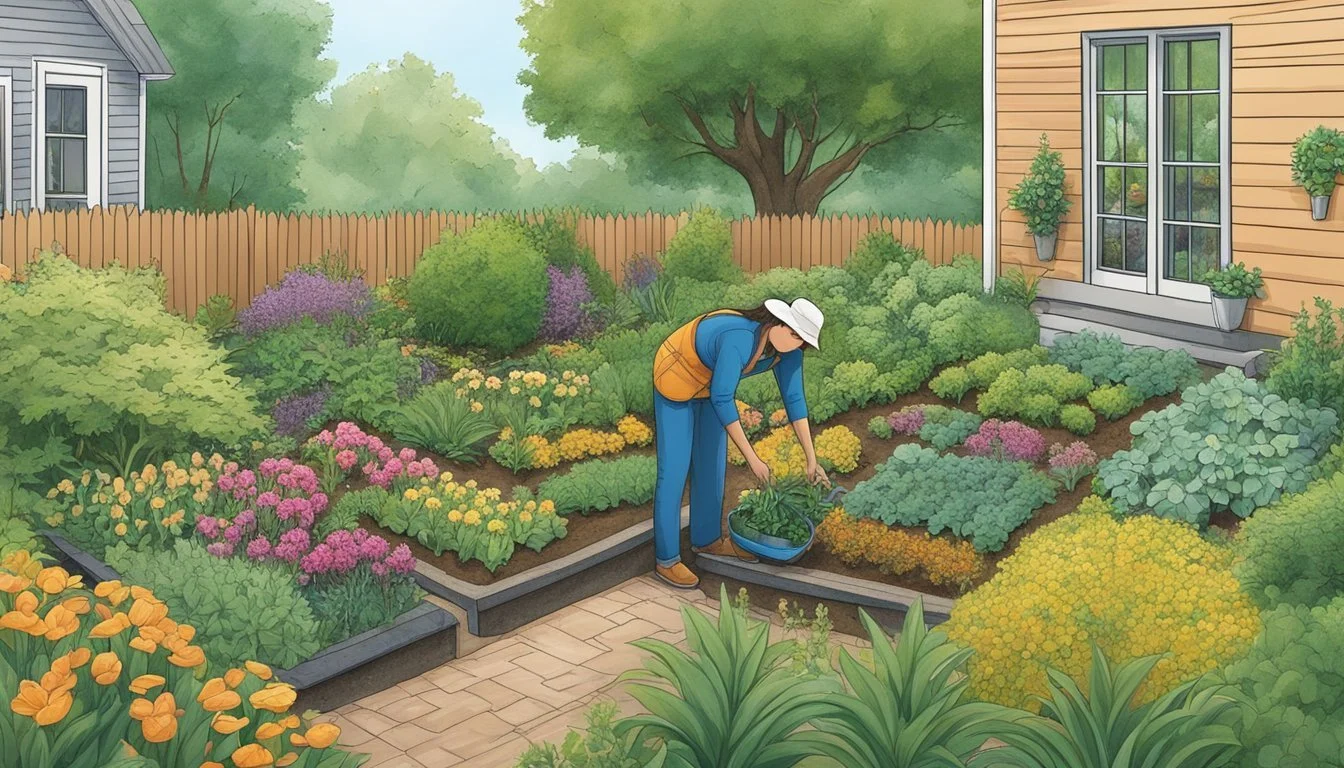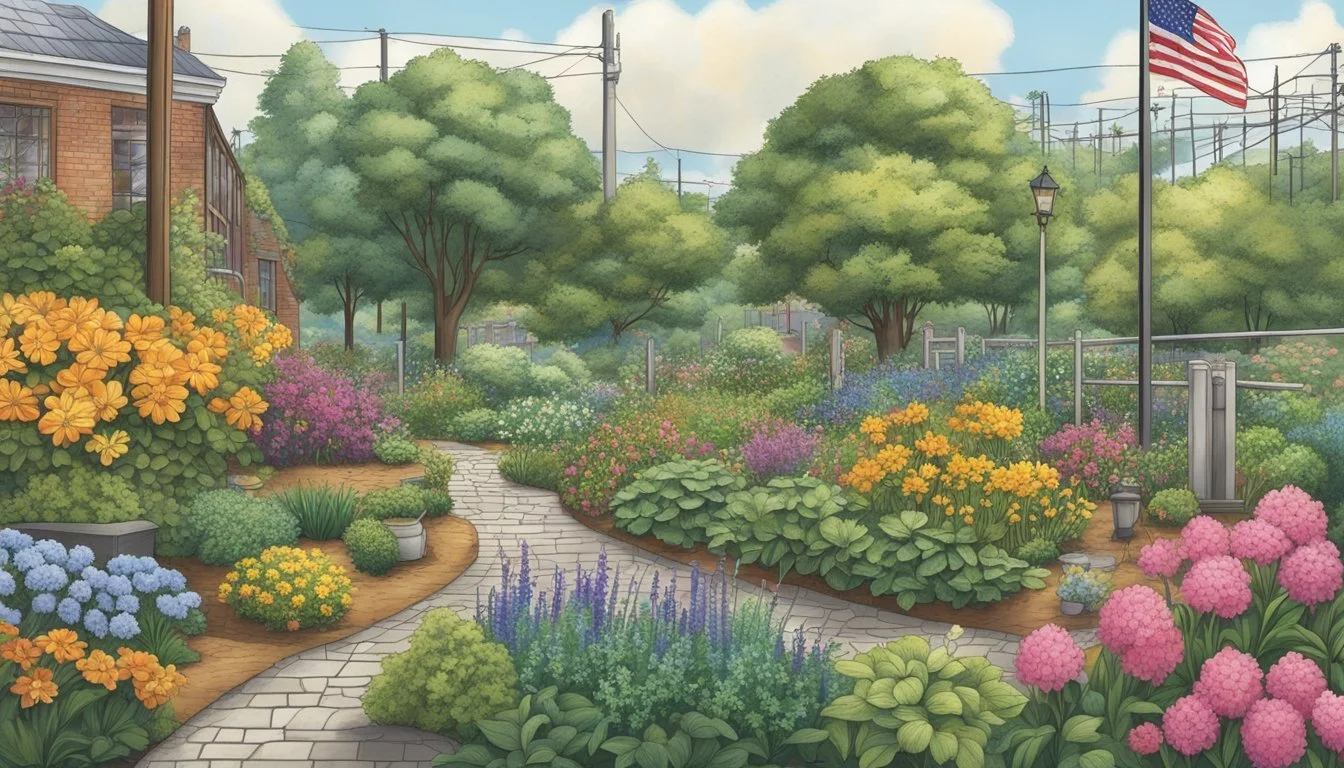USDA Hardiness Zones in New Jersey
A Guide to Planting Success
Understanding the USDA Hardiness Zones is crucial for gardeners and agriculturalists in New Jersey, as these zones guide the planting of perennial plants most apt to thrive in their specific location. The USDA Plant Hardiness Zone Map delineates these zones based on the average annual extreme minimum winter temperature. Updated periodically, the current map reflects subtle shifts in climate patterns and provides essential data for successful horticulture and agriculture, ensuring that growers select plants suited to their locale's weather conditions.
For New Jersey, a state with varied topography and climate, the USDA zones are particularly meaningful. The state is sectioned into several zones, including 5b, 6a, 6b, 7a, 7b, and a portion of 8a, each representing distinct average low temperature ranges. This granular zoning, which can be seen on the New Jersey Hardiness Zone Map, allows for precise planting and planning. Gardeners in New Jersey leverage this knowledge to select plants that have the best chance to withstand the local winter and to map out timing for seeding and transplantation.
Revisions to the plant hardiness zones, such as the 2023 update which can be observed on the USDA's website, are significant to New Jersey's horticultural community. These revisions take into account the recent temperature records and patterns, which can alter the hardiness zones and influence the palette of plants recommended for cultivation. Climate variation impacts not only what can grow, but can also affect when plants should be introduced into gardens and farms across the state.
Understanding USDA Hardiness Zones
The USDA Hardiness Zones are a critical tool for gardeners and growers to determine which plants are most likely to thrive in their specific region. Providing guidance on climate and growing conditions, these zones inform planting and cultivation strategies across the United States.
Definition of USDA Hardiness Zones
USDA Hardiness Zones, developed by the U.S. Department of Agriculture, delineate regions based on their average annual extreme minimum temperature. Ranging from Zone 1, where the temperature can dip below -50°F, to Zone 13, with minimum temperatures above 60°F, these zones assist in selecting plants that will succeed in local climates.
The Importance of Hardiness Zones for Gardeners and Growers
For gardeners and growers, understanding hardiness zones is essential for thriving horticulture. By choosing plants rated for one's specific zone, one ensures better growth success, as the plants are adapted to the area's usual temperature lows.
Overview of USDA Plant Hardiness Zone Map
The USDA Plant Hardiness Zone Map serves as a visual representation of the U.S. divided into these temperature-based zones. The map, accessible via interactive platforms such as the dedicated USDA website, allows users to easily identify their local zone by entering their ZIP code or clicking on their state.
The Role of the U.S. Department of Agriculture
The U.S. Department of Agriculture is responsible for creating and updating the USDA Plant Hardiness Zone Map, a task that involves analyzing temperature records from thousands of weather stations. This map is the authoritative guide for gardeners, informing which plants are appropriate for their location's climate conditions.
New Jersey's Climate and Zones
New Jersey's diverse climate significantly influences the hardiness zones within the state. These zones are essential guides for gardeners to determine the most viable plants for their region based on temperature extremes.
Climate Factors Affecting Hardiness Zones
The climate in New Jersey is categorized as humid subtropical in the south, central, and northeast; and humid continental in the northwest. These climate classifications are primarily determined by temperature fluctuations and precipitation patterns. The state experiences cold winters and warm to hot summers, with extreme minimum temperatures playing a pivotal role in defining hardiness zones. It is these frigid temperatures that could cause perennial plant death, hence mapping them accurately ensures successful plant cultivation.
Mapping New Jersey's Hardiness Zones
The USDA Plant Hardiness Zone Map for 2023 is the authoritative source for identifying the various zones within New Jersey. This map displays zones based on average annual extreme minimum winter temperatures. For instance, Zone 6b encompasses regions with temperatures ranging from -5°F to 0°F, whereas Zone 7b includes areas where temperatures fall between 5°F to 10°F. These zones are delineated by 10-degree Fahrenheit increments, and further refined into 5-degree half zones.
Regional Variations Across New Jersey
New Jersey is geographically small, yet it exhibits significant regional climate variations from the coastal east to the hilly northwest. For instance, the coastal areas tend to be warmer, often corresponding to Zone 7b or even Zone 8a. In contrast, the northwestern part of the state, with its higher elevations and more rugged terrain, can fall within Zones 6a or 6b. This demonstrates that even within a single state like New Jersey, temperature and thus hardiness zones can shift substantially across short distances.
Planting and Gardening in New Jersey
Gardening in New Jersey requires an understanding of the specific climate zones and seasonal timings. The USDA Plant Hardiness Zone Map serves as a fundamental guide for gardeners when selecting plants and determining the best planting strategies to ensure a thriving garden.
Selecting the Right Plants for New Jersey's Zones
New Jersey's gardeners should be acquainted with the state's planting zones, which range from 6b to 8a. These zones are crucial in choosing plants that are likely to prosper year after year. Perennial plants, trees, and shrubs that fit within these zones are more likely to withstand the local climate. For instance, a flower that thrives in zone 6b may struggle in zone 8a due to variations in winter temperatures.
Zone 6b: Suitable for plants that can endure minimum temperatures of -5°F to 0°F.
Zone 7a/b: Offers a moderate climate, suitable for a wide range of plants including many flowering shrubs.
Zone 8a: Supports warmer climate plants which can tolerate minimum temperatures of 10°F to 15°F.
When planning their yard, gardeners should consider not only the climate zone but also the specific conditions of their local environment, such as soil quality and exposure to sunlight and wind.
Timing and Planting Strategies
Effective planting in New Jersey hinges on timing. Gardeners must monitor the local frost dates, planting perennials, trees, or shrubs at the optimal time to prevent damage from late winter or early spring frosts. In general, the best time to plant is after the last expected frost date in the spring or before the first frost date in the fall.
Here are some general planting strategies:
Spring: Ideal for most annuals, some perennials, and vegetables. It gives plants time to establish before the summer heat.
Autumn: Suitable for planting trees and shrubs, giving them time to root without the stress of summer heat and with ample winter rain.
Understanding the Significance of Heat and Winter
Lastly, New Jersey gardeners must not underestimate the impact of heat and winter on plant vitality. Plants not only have to survive the freezing cold but also need to endure the hot and humid summers. An understanding of how plants respond to these conditions can help gardeners protect them from heat damage in summer and cold damage in winter. Mulching, watering strategies, and choosing the right location in the garden are all important factors to consider.
Advanced Tools and Resources
In the ever-evolving world of agricultural research, New Jersey gardeners have state-of-the-art tools at their disposal for determining the most suitable plants for their locale. These resources leverage the latest GIS technology, robust data from the Agricultural Research Service (ARS), and user-friendly web features to provide comprehensive support for agricultural planning.
Interactive GIS-Based Map Features
The USDA Plant Hardiness Zone Map uses Geographic Information System (GIS) technology allowing users to zoom in and out, exploring specific areas with precision. This advanced feature provides detailed insights into how local variables like light exposure and wind patterns may influence plant survival and growth. It's a dynamic tool that supports gardeners in making informed decisions based on the latest updates in plant hardiness zone information.
Utilizing the ARS Website
The ARS website offers an extensive repository of agricultural research findings, including updates on hardiness zones. They emphasize the importance of a broadband internet connection for the best user experience due to the rich, data-intensive content available. ARS's commitment to updating these resources ensures that users have access to current and relevant data for their agricultural planning needs.
Finding Your Zone by Zip Code
For gardeners looking for a quick reference, many websites provide the option to find your hardiness zone by entering a zip code. This simplified tool streamlines the process and is ideal for quick look-ups. Knowing your exact zone can help determine the suitable plants that can withstand the local winter climate of New Jersey, as well as light and wind conditions present in your specific area.
Hardiness Zones Beyond New Jersey
The concept of hardiness zones extends far beyond the borders of New Jersey, providing a framework for gardeners and agriculturists nationwide to understand the likely survival rate of their perennial plants during the winter. The variation of these zones can be seen in the surrounding states and as far away as Alaska and Puerto Rico.
Comparison with Neighboring States
Delaware typically sees zones ranging from 6b to 7b, indicating slightly milder minimum temperatures than some parts of New Jersey.
In New York, one may encounter a wider range of zones, from 4a to 7b, reflecting the more diverse climates across its various regions, from the colder upstate areas to the warmer southeastern parts.
Understanding Half Zones and 10-Degree F Zones
Half zones signify a 5-degree Fahrenheit difference within a 10-degree band, offering a more precise understanding for planting and gardening.
The 10-degree F zones are broad categories that denote average extreme minimum temperatures, providing a general guide for plant compatibility.
Hardiness Zones in Alaska and Puerto Rico
Alaska, known for its cold climate, spans from zone 1a to 8b, signifying the tremendous range of environments within the state.
In contrast, Puerto Rico experiences tropical conditions, reflected in zones 11 to 13, where frost is rare and plant life thrives year-round.
Practical Insights for New Jersey Gardeners
New Jersey gardeners and growers can maximize their horticultural success by understanding the diverse USDA Hardiness Zones within the state and adapting their practices to the varying seasonal conditions.
Local Variations Within New Jersey's Towns and Cities
New Jersey's geography leads to a range of hardiness zones, from 6b in the cooler highlands to 8a along the warmer southern coast. For instance, a gardener in Allendale, classified under zone 6b, would select different perennial plants compared to someone in Avalon, zone 8a. These local variations within cities like Atlantic City and Barnegat Light require gardeners to assess their specific location when consulting the USDA Plant Hardiness Zone Map as their guide.
Absecon – Beachwood: Generally fall within zone 7a, having a distinct range of plants that can tolerate the winter temperatures.
Beattystown – Bloomsbury: These areas can span across zones 6b to 7b, necessitating careful selection of cold-hardy plants.
Seasonal Considerations: From Fall to Spring
Planning plantings and understanding the timing of seasonal changes are critical for gardening success. In New Jersey, fall can be the ideal time to plant spring-blooming bulbs and establish perennials, as cities like Bergenfield and Bernardsville experience first frosts around late October to mid-November.
Fall: Prepare for early frosts in towns like Allamuchy and Andover, and consider protective measures for sensitive plants.
Spring: Coastal towns such as Atlantic Highlands and Avon-by-the-Sea may enjoy earlier thaws, providing an extended growing season.
By recognizing the local and seasonal specificities, New Jersey gardeners can effectively plan and cultivate thriving gardens across the state's varied landscapes.
Frequently Asked Questions
Understanding the USDA Hardiness Zones is crucial for successful gardening and landscaping in New Jersey. This section addresses common queries with authoritative clarity.
How can I determine the right planting zones for different areas in New Jersey?
New Jersey's diverse climate is categorized into several planting zones. Gardeners can view the new 2023 New Jersey Hardiness Zone Map for zone designations ranging from 5b to 7a.
Is there a map that clearly defines the various USDA Hardiness Zones within New Jersey?
Yes, there is a 2023 USDA Plant Hardiness Zone Map tailored to help gardeners identify which plants will flourish in different locations across New Jersey.
What USDA zone does Newark, NJ fall into for gardening and landscaping purposes?
Newark, NJ is generally classified within Zone 7a, indicating its average annual extreme minimum winter temperatures ranges from 0°F to 5°F.
Which plants are best suited for growth in New Jersey's 6b Zone?
Plants suited for New Jersey's 6b Zone must tolerate winter temperatures of -5°F to 0°F. Detailed plant recommendations are available in various gardening guides.
Can you find planting zones in New Jersey based on your zip code?
Planting zones in New Jersey can indeed be located by zip code using the interactive tools found on the USDA's Plant Hardiness Zone Map website.
What are the specific cold hardiness zones across different regions in New Jersey?
Different regions in New Jersey experience varying cold hardiness zones, from 6b to 8a. A statewide map provides a visual representation of these zones, aiding in the selection of appropriate vegetation.







